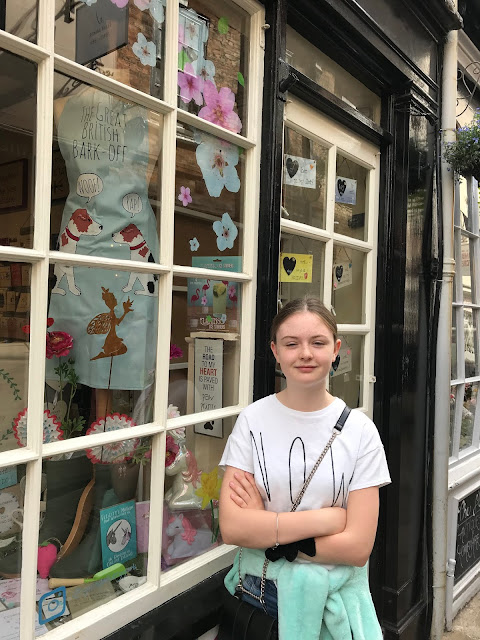August 4, 2018 - Scotland Trip Day 6 - York, Sherwood Forest, Southwell Workhouse, & back to Duffield
On our way "home" to Duffield we made three main stops (See the map below). We spent a few hours in the cute, touristy town of York, before heading on to Sherwood Forest. After that we toured what once was a workhouse for the poor. It was a great way to break up the trip home!
We really enjoyed York, even though our visit was much too brief. It is clear that there is much to see and do there.
We particularly enjoyed exploring the shops on the Shambles. As always we rely on Wikipedia for a description:
The Shambles (officially known as just Shambles) is an old street in York, England, with overhanging timber-framed buildings, some dating back as far as the fourteenth century. It was once known as The Great Flesh Shambles, probably from the Anglo-Saxon Fleshammels (literally 'flesh-shelves'), the word for the shelves that butchers used to display their meat. As recently as 1872 twenty-five butchers' shops were located along the street, but now none remain.
The street was mentioned in the Doomsday Book of 1086. Many of the current buildings are from circa 1350-1475. Among the structures of the Shambles is a shrine to Saint Margaret Clitherow, who was married to a butcher who owned and lived in a shop there at No. 10 Shambles. Her home is now a cufflinks shop, Cuffs & Co, and features the priest hole fireplace that ultimately led to her death.
Although the butchers have now vanished, a number of the shops on the street still have meat-hooks hanging outside and, below them, shelves on which meat would have been displayed. The shops currently include a mixture of eateries and souvenir sellers, but there is also a bookshop and a bakery. Five snickelways lead off the Shambles. A daily market (Shambles Market) operates in the area.
We parked below Clifford's Tower, which was part of York Castle. Wikipedia says the following about the Tower:
The now-ruinous keep of the medieval Norman castle is commonly referred to as Clifford's Tower. Built originally on the orders of William I to dominate the former Viking city of York, the castle suffered a tumultuous early history before developing into a major fortification with extensive water defences. After a major explosion in 1684 rendered the remaining military defences uninhabitable, York Castle continued to be used as a jail and prison until 1929.
From York we drove to Sherwood Forest. We couldn't really be so close to Nottingham and Sherwood Forest for three months without at least taking a look. Though it is highly commercialized (theme park style), Sherwood Forest has some amazing and beautiful old-growth trees! We took a quick, 1-mile walk through them. The picture below is of a statue of Robin Hook and Little John.
The most prominent of the big trees is the "Major Oak." Do you ever get sick of Wikipedia quotes?
The Major Oak is a large English oak (Quercus robur) near the village of Edwinstowe in the midst of Sherwood Forest, Nottinghamshire, England. According to local folklore, it was Robin Hood's shelter where he and his merry men slept. It weighs an estimated 23 tons, has a girth of 33 feet (10 metres), a canopy of 92 feet (28 metres), and is about 800–1000 years old.[1] In a 2002 survey, it was voted "Britain's favourite tree". In 2014 it was voted 'England's Tree of the Year' by a public poll by the Woodland Trust, receiving 18% of the votes.
It is an impressive tree, and we loved seeing it!
From Sherwood Forest we drove to Southwell, to tour what once was a workhouse for the poor. It is now run by the National Trust. It was quite interesting and equally depressing. Here's what the National Trust's website says about it:
Walking up the paupers' path towards The Workhouse it is easy to imagine how the Victorian poor might have felt as they sought refuge here. This austere building, the most complete workhouse in existence, was built in 1824 as a place of last resort for the destitute. Its architecture was influenced by prison design and its harsh regime became a blueprint for workhouses throughout the country.
This rural workhouse was designed to house around 160 inmates. They lived and worked in a strictly segregated environment with virtually no contact between the old and infirm, able-bodied men and women and children
The stories of those who lived and worked here in the 1840s help bring the building to life and prompt reflection on how society has tackled poverty through the centuries.
It continued to be used until the 1990s, as housing for women and children.
This was the food cellar.
The accommodations were stark and simple. The entire place was designed to be difficult living (so as to encourage people to seek employment elsewhere), while keeping people alive.
There was plenty of work to do.
Between the 1970s and 1990s they used the place as a place to house destitute mothers and children. The next couple pictures show how it was during that period.
We had a fantastic time touring Northern England and Scotland! That said, it was nice to be "home" in Duffield. We feel spoiled.






































Comments
Post a Comment